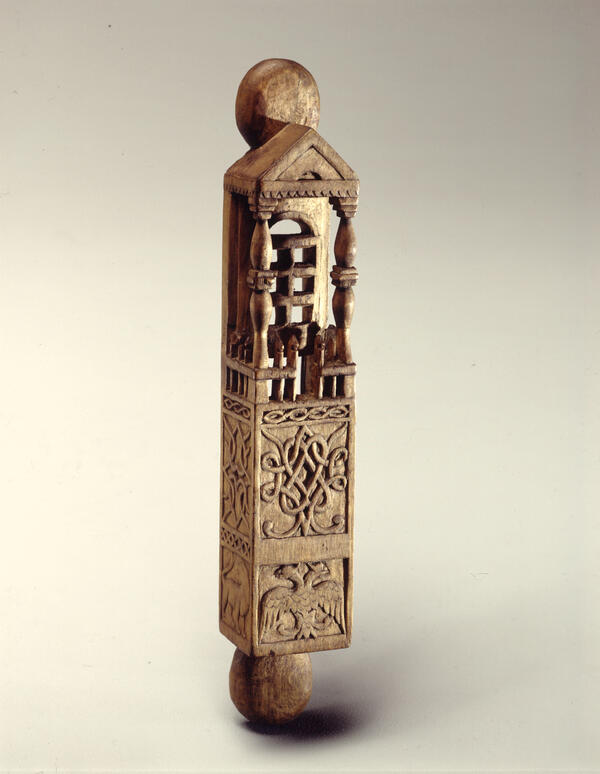Kabbalah, the mystical Jewish school of thought, says,
Mezuzah case
Creation period
the late 19th century
Place of сreation
Galicia, Austro-Hungarian Empire
Dimensions
24x4,5 cm
Technique
wood carving
Collection
1
Open in app#2
#3
He who builds a house must declare clearly that he is building it for the glory of the Almighty.
#4
Judaism is not only about performing rites and rituals in the synagogue; it is a way of living, thinking, and arranging one’s home space. Life in the traditional Jewish home was filled with the rhythm of Sabbath gatherings and farewells, morning and evening prayers, fasting, holiday chores, sewing and reading. The house lived the same spiritual life as the temple.
The Torah, the main sacred document of Judaism, says:
The Torah, the main sacred document of Judaism, says:
#5
And these words, which I command thee this day, shall be in thine heart. And thou shalt write them upon the posts of thy house, and on thy gates.
#6
Jews put scrolls with prayers — mezuzahs — in special cases and attached them with blessings to the doorposts of all the doors leading to the living quarters, except the toilets and bathrooms. The characteristic recesses in the doorway always identify old Jewish homes. The oldest mezuzahs can be traced back to the Second Temple period, 3,500 years ago.
The text of the most famous prayer was written on the scroll of the mezuzah, “Shema Yisroel”, which means, in Hebrew, “Hear, O Israel”. “Hear, O Israel: Lord is our God, the Lord is one!” This was the first verse of the mezuzah text. It proclaimed the covenant, the union between God and the Jewish people.
On the outside of the mezuzah the name of Shadai — the Hebrew for Almighty — was written. It is commonly interpreted as an abbreviation of the phrase “Guardian of Israel’s doors”, as well as the magical formula in which the first verse is encoded. Entering the house, one was to touch the case: it signified the moment of unity with the Creator.
The text on the scrolls of the mezuzah was written by special members of the community, the sofers, the people who copied the Torah, made magical amulets, and drew up marriage contracts. The mezuzah was made of carefully processed parchment made from the skin of a kosher animal. Every seven years the scroll was taken out and thoroughly examined.
Mezuzah cases were made of many different materials. For poor people they could be tin, inconspicuous and without decorations, or in the form of a glass tube with a metal wrap for attaching to the doorpost. Carved wooden cases, with elegant decorations and symbols of Judaism, were of particular value.
The text of the most famous prayer was written on the scroll of the mezuzah, “Shema Yisroel”, which means, in Hebrew, “Hear, O Israel”. “Hear, O Israel: Lord is our God, the Lord is one!” This was the first verse of the mezuzah text. It proclaimed the covenant, the union between God and the Jewish people.
On the outside of the mezuzah the name of Shadai — the Hebrew for Almighty — was written. It is commonly interpreted as an abbreviation of the phrase “Guardian of Israel’s doors”, as well as the magical formula in which the first verse is encoded. Entering the house, one was to touch the case: it signified the moment of unity with the Creator.
The text on the scrolls of the mezuzah was written by special members of the community, the sofers, the people who copied the Torah, made magical amulets, and drew up marriage contracts. The mezuzah was made of carefully processed parchment made from the skin of a kosher animal. Every seven years the scroll was taken out and thoroughly examined.
Mezuzah cases were made of many different materials. For poor people they could be tin, inconspicuous and without decorations, or in the form of a glass tube with a metal wrap for attaching to the doorpost. Carved wooden cases, with elegant decorations and symbols of Judaism, were of particular value.
#7
Ministry of Culture of the Russian Federation
read morehide
00:00
00:00
1x
Mezuzah case
Creation period
the late 19th century
Place of сreation
Galicia, Austro-Hungarian Empire
Dimensions
24x4,5 cm
Technique
wood carving
Collection
1
Open in app
Share



